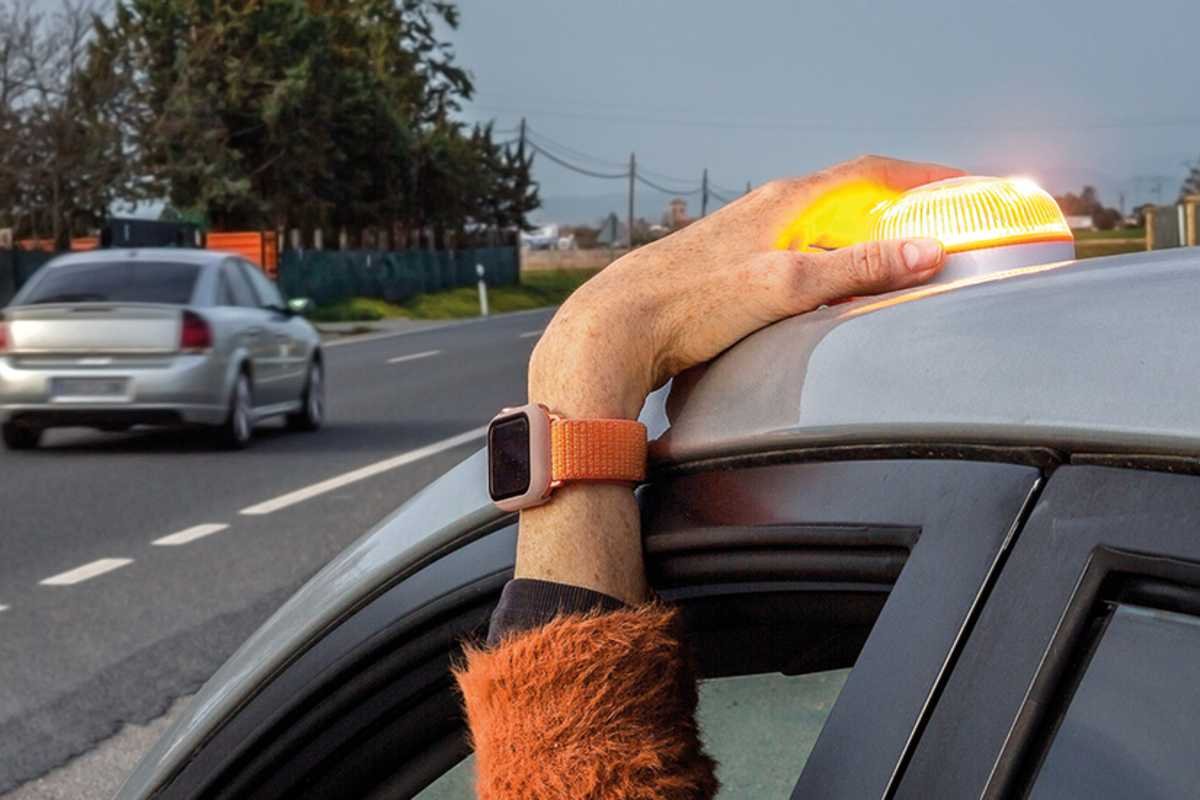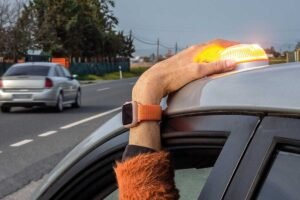Spain is introducing a major change to road safety requirements, especially important for visitors and residents. Starting January 1, 2026, the traditional warning triangle will no longer be sufficient in the event of a breakdown or accident. Instead, all vehicles must carry a DGT‑approved connected V‑16 emergency beacon, replacing both the old triangle and the non‑connected version.
This reform aims to improve safety on Spanish roads by reducing roadside risks and integrating real‑time hazard alerts into the national traffic system. But what exactly is the V‑16 beacon, who must have it, and why is it so important? Here’s what you need to know before driving in Spain after the new law takes effect.
Table of contents
What Is the V‑16 Emergency Beacon?
The V‑16 beacon is a yellow flashing light—also called a hazard warning device—designed to be placed on a vehicle from the inside when it is stopped or broken down. It emits a 360° visible signal and must be positioned as high as possible, usually on top of the car, via a magnet or other means.
Introduced legally in July 2021 as an alternative to warning triangles, the V‑16 beacon’s design aims to eliminate the need for drivers to exit the vehicle on busy roads. Powered by batteries or cells for at least 18 months, it offers clear visibility up to 1 kilometer—even in fog or rain—and operates for at least 30 minutes.
Why Is the V‑16 Beacon Now Mandatory?
Traffic authorities in Spain cite shocking figures: nearly 22 fatalities per year involved drivers placing triangles on high-speed roads. The beacon removes this risk, as it can be deployed from within the vehicle.
Moreover, modern beacons are required to connect to the DGT 3.0 platform, sending encrypted geolocation data every 100 seconds. This enhances hazard awareness for other drivers and emergency services.
Under a European Directive (2019/741) and Royal Decree 159/2021 (amended in 2022), Spain has taken a leading step in road safety innovation.
Key Dates and Legal Framework
- July 1, 2021: V‑16 beacons became legal alternatives to triangles
- January 1, 2026:
- Traditional triangles and non‑connected V‑16s will be illegal.
- Only DGT‑approved connected V‑16 beacons are permitted.
- The beacon must remain activated until the vehicle or hazard is resolved.
Drivers without one from 2026 face fines between €80 and €200.
What Specs Must the Beacon Meet?
To meet legal standards, the V‑16 beacon must:
- Emit a yellow/orange flashing light, 360° horizontal & ±8° vertical, visible up to 1 km and for at least 30 minutes.
- Be battery-powered with minimum 18 months autonomy and IP54 weather resistance for rain and dust.
- Include a valid homologation code (e.g., LCOE or IDIADA), clearly displayed.
- Feature 12 years of prepaid connectivity via eSIM, sending location data to DGT 3.0
- Have a magnetic or stable base to place it on varied vehicle surfaces, especially tall vehicles .
How to Buy, Use & Stay Compliant
Buying
Connected V‑16 beacons are available now at around €40–50 in supermarkets, auto shops, or online . Make sure they are DGT‑approved and include prepaid connectivity.
In France, tourists are already being advised to purchase one before traveling to Spain
Using
In case of breakdown or accident:
- Activate the beacon from inside the car.
- Place it on the vehicle roof or driver’s door with a magnet—no need to step outside
- An alert with your location is automatically sent, improving visibility and safety .
Compliance
Keep your beacon easily accessible (e.g., in glovebox), regularly check battery status, and ensure it’s properly charged. Non-approved or non-connected versions will render you non-compliant after 2026 .
What Tourists Should Know
If you’re driving in Spain as a tourist:
- From Jan 1, 2026, you must carry the connected V‑16 beacon—even in rental cars
- Without it, you risk fines up to €200
- You do not need a triangle if your beacon is homologated.
- For cross-border travel:
- Spanish-registered vehicles abroad must also carry one
- Foreign cars in Spain under “international circulation” can use their home country’s triangles or the V‑16
Benefits for You and Everyone Else
The connected V‑16 beacon brings multiple advantages:
- Enhanced safety: no need to exit the vehicle, reducing roadside danger
- Greater visibility: bright lights work in rain, fog, or darkness, detectable up to 1 km .
- Real-time alerts: DGT and other drivers are informed of your vehicle’s exact position
- Eco and tech-friendly: many models are recyclable, compact, and include app-based extras like assistance .
- Legal peace of mind: adherence to EU and national road safety laws.
Final Takeaways Before You Hit the Road
- Buy a connected V‑16 beacon now – available in Spain and highly recommended for foreign drivers.
- Check homologation – look for DGT approval and the connectivity eSIM inside.
- Practice deployment – set it up from inside your vehicle in 30 seconds or less.
- Store it accessibly – keep it charged and in your glovebox for emergencies.
- Comply or pay – after January 1, 2026, traditional triangles will lead to fines up to €200.
Spain’s rollout of the connected V‑16 beacon marks a leap in road safety—reducing roadside risk while modernizing emergency alerts. Whether you’re visiting or living here, being prepared isn’t just smart—it’s mandatory.
Safe travels—and keep the beacon visible! 🚗✨
















